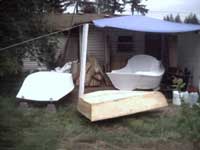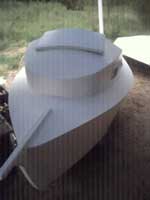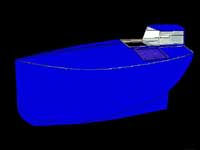|
Impossible Dream |

|
|
By Kristofer J. "Harley" Harlson - Lynnwood, Washington - USA |
Can the 8-foot ‘Sea Biscuit’ and her skipper
survive a journey around
the world, non-stop,
unassisted, by way of the five Capes?
I expect to log some 27,500 miles in the next 12-14 Months in my tiny craft starting this summer. Many have asked, “Can it really be done?” It is a quandary.
How exactly does one prepare for such an undertaking? How can you possibly fit enough food in an eight-foot boat to make it all the way around the globe without having her supplies replenished? How can you fit enough water in such a small boat? Can an eight-foot boat even survive the journey? All are obvious, but very good questions.
 |
"Sea Biscuit" and her designer, builder, and skipper, “Harley” Harlson
(click images for larger views) |
|
When Chuck Leinweber, the Editor of Duckworks Magazine, contacted me to request an article, I was naturally, quite flattered and immediately responded in the affirmative. Now that I sit in front of this keyboard, I’ve got a question of my own! How can I even explain the desire for such a ludicrous adventure? I guess I’ll just have to bore your kind readers with some history, Chuck!
Back in the late Sixties and early Seventy’s, when I first tore myself from access to my Father’s Erickson 23, I had an acquaintance that was an apartment dweller. He had a small inflatable sailboard that he loved to sail out on Puget Sound in my Home State of Washington. He would skim past the “Yachties” in their tubby fiberglass boats and they would stare at him, mouths agape, as if he had no business being out there. They would scoff, and toss beer bottles at him, and tell him to go back to land before he drowned himself. I loved this concept, of course, and couldn’t wait to find some way to join in on the fun. It would be many years before I did so. Finally, the idea came to me that, Yeah! It was possible to build a sailboat without spending a fortune. It was my thinking that if it floated, and it looked somewhat like a sailboat, and sailed like a sailboat, then by all rights, it WAS a sailboat. Never mind the fact that it may be constructed with nails and Elmer’s glue and a bunch of wood tore off old pallets. Ignore that it had a bedsheet for a sail. I could be out there, thumbing my nose at the “Yachties” as I skimmed across the bay.
I never had the resources to buy a real boat, and even when I finally did, I could see no reason to do so. I loved my home-designed and home-built boats. Even in my advancing years, (I’m now 53), I still enjoy sailing by on the receiving end of those jeers and catcalls. Sometimes, I sail by faster than the $4000 daysailers, and that really irks their skippers. The Coast Guard, attracted by my sails of blue plastic tarpaulin, often hounds me to see if I have the required safety equipment on board. Sometimes I don’t and an RIB escorts me back to shore as the folks that watched me launch, snicker and laugh aloud at my folly.
My back yard becomes “Harley’s Boat Shop”. I love to design and build boats that can be made from hardware store fodder and scrap wood and I splatter them with a quick layer of house paint that dries on the way to the lake. And, by George, I do go sailing!
| Harley’s Boat Yard with three boats under construction, an eleven foot cruiser, a 12 foot boat from two sheets of cheap 3/8th inch plywood sheathing, and an one-sheet boat, the Harley-8, awaiting a quick slather of Latex exterior housepaint. |

|
|
By now, I’m designing and building and sailing these boats and just plain having fun. But, each time I go out, and I lay basking in the sun with my feet on the gunwale and fingertips gently guiding my creations by their scrapwood tiller, I return to the dreams of my childhood.
As a young man I read the stories of Kenichi Horie crossing the Pacific in his 19-foot plywood Mermaid, Robert Manry’s unforgettable journey across the Atlantic in the tiny 13-foot Tinkerbelle. I marvel at Thor Heyerdahl’s raft, the Kon-Tiki and follow Robin Lee Graham around the world in National Geographic Magazine. It’s all I want to do. I can’t get it out of my mind. I want to build a Cabin on my Dad's 16 ft. modified Crescent-Class plywood sailboat and sail her across an ocean just as my heroes did. My father tells me that a 16 ft’ boat is too small for a cabin. Instead, life and adulthood are cast upon me, and the dream dies to a cool ember, perhaps asleep forever.
Then something happened. My wife, Alice, made a really big mistake. She said, “ Honey,” trying to get me out of the house so she could have some friends over, “The tall ships that sailed through Seattle are all up in Everett now.” “Why don’t you take a drive up there and see them all before they sail away?” She is well aware of my love for sailing, as I’ve often spoken of all the times I sailed with my Dad, and how they are the fondest memories of my life. She doesn’t know what she is about to awaken. The long sleeping dream of my childhood glowed imperceptibly, deep down in the very recesses of my heart, awaiting the fanning of forgotten desire. I drove to Everett that Sunday, but I was too late. The ships had already sailed away that morning. I didn’t want to disturb my spouse’s house party so I stayed in Everett and decided to browse the Everett Marina, and look at the sailboats moored along the docks. It was too late. The dream boiled hungrily to the surface, and suddenly, the small plywood boat I was working on, in my mind, was waiting for that cabin that never got built in my childhood. What was going to be a little eleven-foot cartopper suddenly sprouted a keel and a cabin. As I worked on the little boat, my lovely Wife looked upon the scene and said, “You’re not going to sail that boat across an Ocean.” I had a reply already waiting. “ But, “ I started, “What if I have to?”
| “Beginner’s Luck” sprouts a deck, cabin, and bowsprit. |

|
|
I began to reveal my plans to friends and family. I was going to sail my little boat, “Beginner’s Luck” to Australia and back. As I was planning my trek across the Pacific, it occurred to me that Australia was halfway around the world. Why not, instead of coming back across the Pacific, just keep on around and complete a circumnavigation? I had read Serge Testa’s book “500 Days”, and it didn’t take long before I realized that if I did so, I’d be breaking Serge’s World Record for the smallest boat to circumnavigate the globe. I began to take a lot of pride in that, to my own surprise, and after a while I began to think of it as MY World Record! But as I was surfing the World Wide Web, something else happened. Something that would change everything…. Again.
A picture on the web caught my attention. There he was, either he or a friend, posed straining against his 9-foot Mini-cruiser showing off a portion of his backside usually associated with overweight plumbers: a man who called himself “Admiral Dinghy”, according to the caption. He was planning to sail his 9-foot boat around the World. I was devastated. I had no idea that I had become so attached to the idea of obtaining that World Record. Only one thing could be done. I couldn’t let him take it from me. I couldn’t chance that anyone would take it from me.
And it wasn’t even mine yet.
I panicked. Where were all my drawings? I tore through my files. I had designed a hundred boats by now, surely amongst the sketches; there was an answer to my problem. I knew there was. Ah! There they were! A series of drawings I had done when daydreaming about miniature ocean cruisers. I looked them over. No. There were ideas, but not an answer. These boats were all too blocky. Flat-bottomed variations of Bolgeresque mini-visions. I would have to start anew. If a half-bare-bottomed “Admiral Dinghy” was going around in a 9-foot boat, then I was going around in an 8-footer. And to sweeten the pot, to be sure of a World Record voyage, I was going to go around Non-Stop.
 |
A Concept Sketch of Sea Biscuit’s Hull
|
|
A spiral notebook became a sketchpad. Paper models were made from its pages with clear adhesive tape. I want her to be as fast as I can make her. How do you make a plywood hull that is round on the bottom? I took a sheet of paper and held it in a half-barrel shape. I gazed, and thought. I pinched the paper on one end and tried to make a bow shape. Yeah, that’s almost right. But it dipped downward where I’d pinched it. This won’t do. I want it to slant upward, not downward! And how can I make the stern slant upward as well? I remembered seeing something on the web about a guy who made a long canoe from a single sheet of plywood by cutting long thin triangles from it and joining them together. Yeah. That’s the ticket. I grabbed the scissors and cut triangular sections out of the piece of paper and joined the remaining sections together with tape. To my amazement I had a nice barrel shape that would join to a flat transom. I did the same at the other end of the barrel-shaped paper and found that now when I squeezed the end together to form a bow, it sloped upwards as it should. Damn I’m good. Back to the drawing board.
Sketch upon sketch was drawn. I re-read everything I could find about all the other small boat voyagers with a special eye toward problems that they had encountered. I found even more stories and scoured them for information. I borrowed a one-piece plywood keel structure from Gerry Spiess’ ‘Yankee Girl’.
I designed a ventilation system to overcome the difficulties that Hugo Vihlen had experienced with his ‘Fathers Day’ Trans-Atlantic voyager, and designed a kayak-like membrane to go around my mid-section as I poked myself through the hatch to keep the seas out. Hugo once had his boat submarine while he was standing in the hatch! He dared not try to go below to try an slam the hatch shut because his body was the only thing keeping the water from sinking his boat, so he held his breath for an eternity till the boat resurfaced. I moved the Hatch toward the middle of the boat to keep the waves from pooping the boat and washing right into the hull. I designed a little doghouse for the rear to see out of and built it from thick bulletproof Lexan scavenged from a bank teller’s window when the bank was torn down. I lined her hull with a layer of Galvanized steel fabric and bonded it to the hull with flexible polyurethane. The deck was covered with a graphite/Kevlar hybrid fabric bonded to the hull with epoxy. The hull was covered with Kevlar fabric; the seams reinforced with Woven roving and then another layer of fiberglass and epoxy. The interior was built up with ribs laminated in every ten inches. ½ inch thick blocks of scrap steel were bonded to the inside of the bottom as ballast. The entire inside was covered with 3 ½ inches of closed-cell foam as floatation and insulation and then an inner hull was built up of fiberglass and resin. Her hull was coated on the bottom with Interlux Antifouling paint.
 |
For more pictures of "Sea Biscut" see: The Impossible Dream
Album Page
|
|
I adapted her rig from Ted Brewer’s SO-DU-IT!, except that Sea Biscuit's masts would stand straight up instead of raking forward. This avoided the balance problems that SO-DU-IT! Had when she was roller-reefed. Like Gerry Spiess’ ‘Yankee Girl’, ‘Sea Biscuit’s supplies double as both ballast and floatation. I‘ve no room for water so I purchased two Katadyn Survivor 35 hand-pumped desalinators to create my own fresh water from seawater, I spent month upon month scouring books and the web for food technologies that could get me
around, and still fit in ‘Sea Biscuit’s’ very limited storage spaces that consist of her bilge and a long cabinet built on each side of my berth. (Photographs of much of this can be viewed on the Impossible Dream Album page.) I’m bringing a Yuloh to waddle my way out of the way of ships in a calm. I’m bringing extra sails and sailcloth for making repairs. I’m bringing four extra Jury masts in the form of telescoping poles that can be stayed for strength.
I’ve considered every possible scenario and countered it with design and preparation. I’ve never heard anything again of “Admiral Dinghy”. My only competition at this point has been Eric Humphreys from The Captain Humphreys Project, who has largely given up his idea of going around in an eleven-foot boat because of my efforts. Am I really going to try to sail around the world non-stop? To quote a well-known fictional character from the movies, “There is no try. There is do, or don’t do.” Sea Biscuit and I depart this June.
-Kristofer J. “Harley” Harlson
-Sea Biscuit Around the World 2006-2007
For more pictures of "Sea Biscut" see:
Impossible Dream Album Page

|